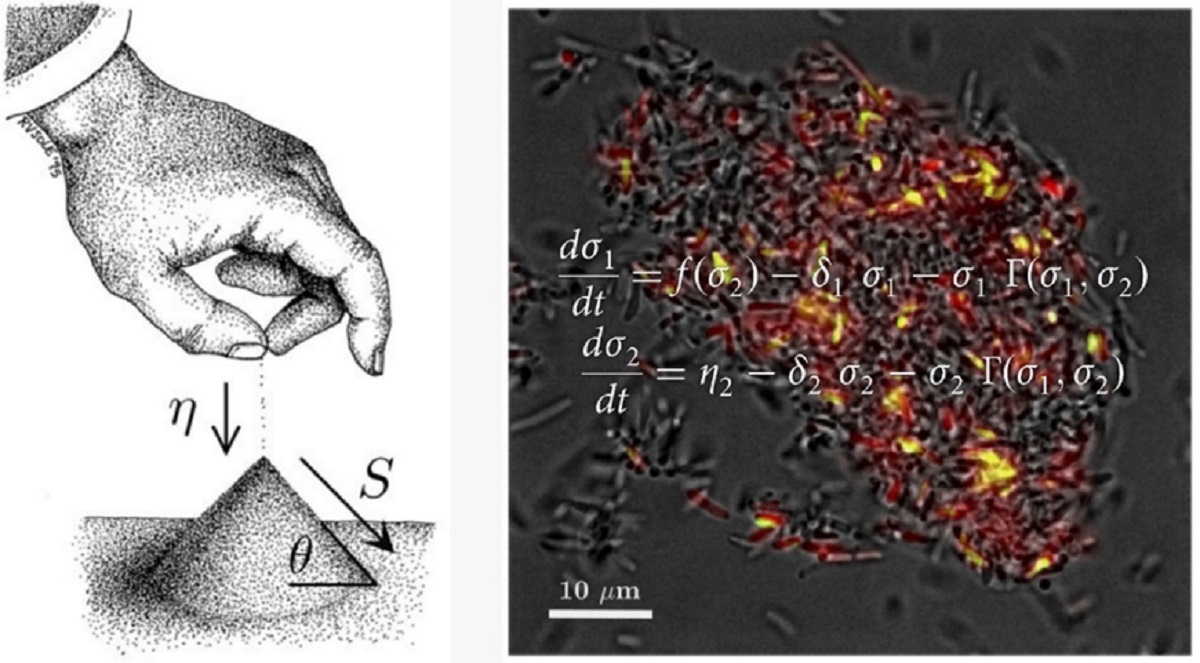A study points to the possibility of inducing critical states in living cells
A multidisciplinary team led by Institute of Evolutionary Biology (IBE) has managed to create a genetic circuit that allows living cells to reach critical states, stimulating new patterns of behavior.
This study, recently published in the journal Nature Communications, may help to better understand the origin of cognition, and even improve the administration of drugs against tumors.

These summer days it is very common to find children on the beach playing and making sand piles, creating bigger and bigger mounds, and observing the small avalanches that are created on their slopes. When the pile of sand grows, its slope reaches a critical point at which, once it has been reached, if we deposit more sand, it will slide and fall in the form of avalanches of different sizes. At its highest point, the sand pile is in a critical state between order and instability.
This is known as self-organized criticality (SOC), a principle proposed in 1987 by Danish physicist Per Bak by means of which the small interactions between the elements of a system naturally arrive at this critical point, where a minor event can generate responses of varying magnitudes, in some cases catastrophic. This principle is observable in many other complex systems that show states close to their critical points, such as earthquakes, financial markets, traffic and, also, the evolution of living organisms.
Now, a multidisciplinary team led by researchers from the Institute of Evolutionary Biology (IBE), a joint centre of the Spanish National Research Council (CSIC) and Pompeu Fabra University (UPF) have succeeded in introducing the minimum conditions for the dynamics of SOC in living cells (bacteria), by engineering the interaction between command and control parameters, in a simple two-gene network design. The study, which has combined the efforts of a team with expertise in biology, physics, biomedical engineering and mathematics from the IBE in collaboration with the Centre de Recerca Matemàtica (CRM), opens the door to use synthetic biology to design new patterns of behavior and study the origins of cognition.
The study opens the door to use synthetic biology to stimulate new patterns of behavior and study the origins of cognition
A remarkable advance in the field of synthetic biology
According to Ricard Solé, principal investigator at the Complex Systems Lab from IBE and co-corresponding author for the study with researcher Núria Conde, "brains, swarms or even societies present complex fluctuations consistent with the so-called critical state, right on the border between order and disorder. This state allows these systems to respond quickly to environmental changes."
In biology, organisms show an intricate variety of response mechanisms to external stimuli. Adaptive responses require dynamic functions that combine low energy cost with the ability to make changes quickly to efficiently respond to environmental alterations. “What about individual cells?” Solé wonders. “In this study, we have mathematically analyzed and created in the laboratory a new genetic circuit that works within cells and enables them to develop critical dynamics.”
The research team's study, recently published in the journal Nature Communications, points out that, at cellular level, enzymatic networks could be at the threshold of this critical state, and the balance between disorder and order would serve to stimulate the ability to adapt. It is known, however, that critical states are part of the cognitive equipment of multicellular organisms, from the simplest, non-neuronal organisms to collectives of animals. Being in a critical state can have important consequences related to efficiency and can be relevant for information processing tasks as well.
"This opens up the possibility of designing new behavior patterns and studying the origins of cognition at smaller scales" says Solé. This same method could be used to achieve relevant functionalities, such as improving the delivery of drugs against colorectal tumors.
Reference article: Vidiella B, Guillamon A, Sardanyés J, Maull V, Pla J, Conde N, Solé R. Engineering self-organized criticality in living cells. Nat Commun 12, 4415 (2021). doi.org/10.1038/s41467-021-24695-4
